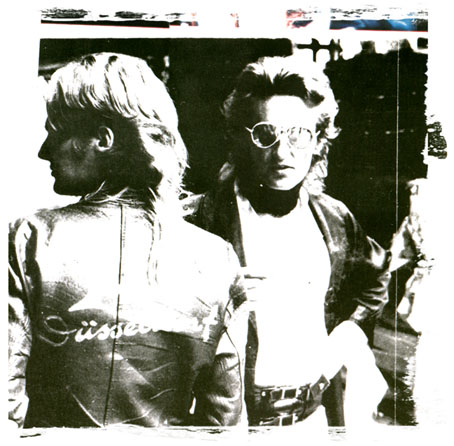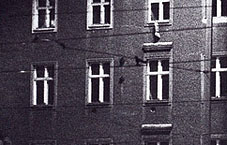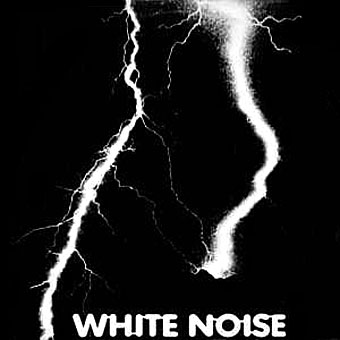Brian Eno: The professor of rock
| Eno at 60.
Tag: Brian Eno
Klaus Dinger, 1946–2008

Klaus Dinger (right) with brother Thomas, circa 1978. From the sleeve of Viva by La Düsseldorf.
“There were three great beats in the ’70s: Fela Kuti’s Afrobeat, James Brown’s funk and Klaus Dinger’s Neu! beat.” Brian Eno
Klaus Dinger, the great drummer for Neu! and La Düsseldorf (and briefly Kraftwerk in 1971) died back in March but news of this has taken a while to emerge. Everything he did in the Seventies is essential, the Neu! albums especially. YouTube has a few choice examples such as this clip of someone playing Neu!’s finest (and oft-imitated) moment, Hallogallo, slightly too fast. Then there’s Isi from Neu! 75 and the crazy glam-punk of Hero (a tremendous period performance) shortly before guitarist Michael Rother left and the band transmuted into La Düsseldorf. For a blast of the latter, there’s the majestic Rheinita from Viva. Happily, Michael Rother is still with us and was interviewed in the most recent issue of The Wire.
Previously on { feuilleton }
• Aerodynamik by Kraftwerk
• Metabolist: Goatmanauts, Drömm-heads and the Zuehl Axis
• The genius of Kraftwerk
Fragment Endloss by Robert Henke
I’ve mentioned before that Robert Henke, aka Monolake, is one of my favourite electronic musicians, and it was great last year when he reinstated his habit of offering a free download each month. Unlike the short fragments or scraps that many artists throw for free to audiences there’s been some substantial work on offer, such as an hour-long live performance of his Layering Buddha set.
The download for this month is a perfect soundtrack to accompany the New Year chill, Fragment Endloss, a 30-minute piece of ambient drift from 1992, reworked slightly for 2008.
This is a very personal piece for me, created in a time where I felt quite dark and lived in an appropriate environment. I just had moved from West-Berlin, Neukoelln, to the east, to Prenzlauer Berg, which at that time was not the expensive hippster neighborhood it is now, but the very opposite. I lived in a small place on the ground floor in a backyard, with a coal oven and a toilet outside the building… It was the end of winter, cold, unfriendly, and very dark. Pretty much like on the pictures above.
Musically this is influenced by ‘The Pearl’ (Brian Eno, Harold Budd). Sound design wise it shows that I just go the TG-77 and SY-77, and then there is this one long brass-like sound that I made as a result of listening to John Chowning.
For the free track of the month version I slightly edited the original 45 minute version and added field recordings of Bahnhof Zoo and the S-Bahn here in Berlin which I also captured in 1992.
Previously on { feuilleton }
• Live Performance in the Age of Supercomputing
• Layering Buddha by Robert Henke
• New Monolake
White Noise: Electric Storms, Radiophonics and the Delian Mode
Many sounds have never been heard—by humans: some sound waves you don’t hear—but they reach you. “Storm-stereo” techniques combine singers, instrumentalists and complex electronic sound. The emotional intensity is at a maximum. Sleeve note for An Electric Storm, Island Records, 1969.
An Electric Storm by White Noise is reissued in a remastered edition this week. It’s a work of musical genius and I’m going to tell you why.
Hanging around with metalheads and bikers in the late Seventies meant mostly sitting in smoke-filled bedrooms listening to music while getting stoned. Among the Zeppelin and Sabbath albums in friends’ vinyl collections you’d often find a small selection of records intended to be played when drug-saturation had reached critical mass. These were usually something by Pink Floyd or Virgin-era Tangerine Dream but there were occasionally diamonds hiding in the rough. I first heard The Faust Tapes under these circumstances, introduced facetiously as “the weirdest record ever made” and still a good contender for that description thirty-four years after it was created. One evening someone put on the White Noise album.
It should be noted that I was no stranger to electronic music at this time, I’d been a Kraftwerk fan since I heard the first strains of Autobahn in 1974 and regarded the work of Wendy Carlos, Tangerine Dream, Brian Eno and Isao Tomita as perfectly natural and encouraging musical developments. But An Electric Storm was altogether different. It was strange, very strange; it was weird and creepy and sexy and funny and utterly frightening; in places it could be many of these things all at once. Electronic music in the Seventies was for the most part made by long-hairs with banks of equipment, photographed on their album sleeves preening among stacks of keyboards, Moog modules and Roland systems. You pretty much knew what they were doing and, if you listened to enough records, you eventually began to spot which instruments they were using. There were no pictures on the White Noise sleeve apart from the aggressive lightning flashes on the front. There was no information about the creators beyond their names and that curious line about “the emotional intensity is at a maximum”. And the sounds these people were making was like nothing on earth.
Continue reading “White Noise: Electric Storms, Radiophonics and the Delian Mode”
Scott Walker on film
Scott Walker: 30 Century Man is a long-overdue look at one of the most influential and enigmatic figures in rock history. The film will explore his music and career, from his early days as a jobbing bass player on the Sunset Strip, to mega-stardom in Britain’s swinging 60s pop scene as lead singer of The Walker Brothers, to his evolution into one of the most astonishing soundmakers of the last few decades.
He’s 63 years old and has just released his first album in over 10 years, The Drift on 4 AD Records. The film features exclusive behind-the-scenes footage of the making of the album as well as interviews with friends, collaborators, and fans including, among others:
David Bowie, Radiohead, Jarvis Cocker (Pulp), Brian Eno, Damon Albarn (Blur, Gorillaz), Neil Hannon (The Divine Comedy), Marc Almond, Alison Goldfrapp, Sting, Dot Allison, Simon Raymonde (Cocteau Twins), Richard Hawley, Rob Ellis, Johnny Marr, Gavin Friday, Lulu, Peter Olliff, Angela Morley, Ute Lemper, Ed Bicknell, Evan Parker, Benjamin Biolay, Hector Zazou, Mo Foster, Phil Sheppard, Pete Walsh, and more.
Directed by Stephen Kijak, who brought you the delightfully deranged documentary CINEMANIA (a profile of 5 of NYC’s most manic film buffs), this is a different form of obsession altogether. Inspiring god-like devotion from fans, Scott Walker’s has a cult that has grown considerably since his 1995 release Tilt, a dark and difficult masterwork. His new album takes that sound further than anyone could have imagined?
Collaborators include acclaimed DP/Director Grant Gee (Radiohead: Meeting People is Easy) and Graham Wood, formerly of legendary design collective Tomato.
Produced by Mia Bays, Liz Rose and Stephen Kijak
Associate Producer: Gale Harold
Executive Producer: David Bowie
On release in the UK from April 27th. Details here.
Previously on { feuilleton }
• Exodus art and Plague Songs
• The Drift by Scott Walker



